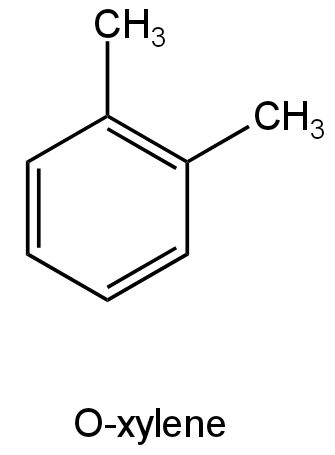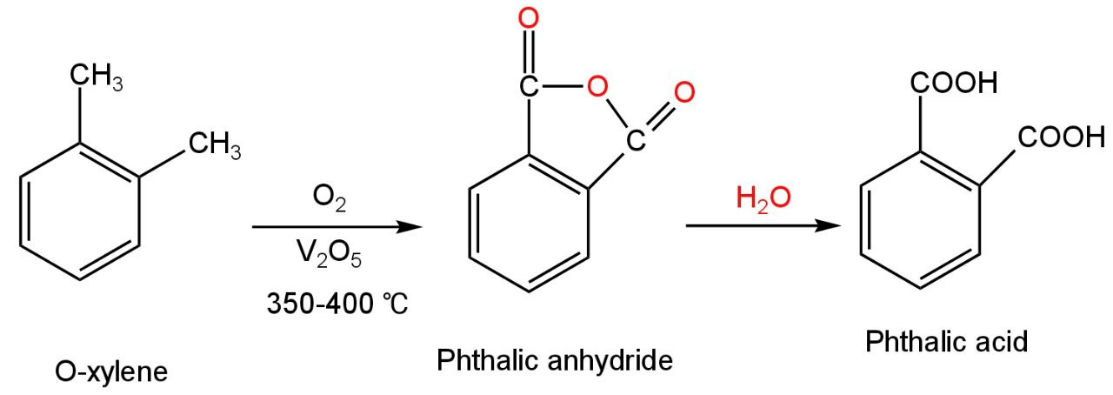
o-xylene when oxidised in presence of \[{{\rm{V}}_{\rm{2}}}{{\rm{O}}_{\rm{5}}}\] the product is
A. Benzoic acid
B. Phenylacetic acid
C. Phthalic acid
D. Acetic acid
Answer
221.7k+ views
Hint: Xylene or dimethyl benzene refers to the organic compounds with the formula \[{\left( {{\rm{C}}{{\rm{H}}_{\rm{3}}}}\right)_{\rm{2}}}{{\rm{C}}_{\rm{6}}}{{\rm{H}}_{\rm{4}}}\]. These originated from the replacement of two hydrogen atoms with methyl groups in a benzene ring.
Complete Step by Step Solution:
Xylene has three structural isomers.
The position of hydrogen atoms that are replaced decides which of the three structural isomers is formed.
There is ortho-substituted xylene or xylene or 1,2-dimethylbenzene, para-substituted xylene or p-xylene or 1,3-dimethylbenzene and meta-substituted xylene or m-xylene or 1,4-dimethylbenzene.
Ortho-xylene structure is as follows:

Image: Ortho-xylene
Vanadium(V) oxide or \[{{\rm{V}}_{\rm{2}}}{{\rm{O}}_{\rm{5}}}\]has a high oxidation state and behaves as an oxidizing agent.
When it is treated with xylene at 350-400 °C temperature, phthalic anhydride is formed as the product.
Then the phthalic anhydride on treatment with water forms phthalic acid.
The reaction occurs as follows:

Image: Oxidation of o-xylene.
The oxidation of o-xylene in presence of vanadium(V) oxide does not produce benzoic acid or phenylacetic acid or acetic acid.
So, options A, B, and D are incorrect.
So, option C is correct.
Additional Information: Xylene is an uncoloured, explosive, little greasy liquid of tremendous industrial value.
Significant usage of vanadium(V) oxide is the manufacture of sulfuric acid.
Vanadium(V) oxide performs the important objective of catalysing the oxidation of sulphur dioxide to sulphur trioxide by air in the contact process:\[{\rm{2S}}{{\rm{O}}_{\rm{2}}}{\rm{ + }}{{\rm{O}}_{\rm{2}}} \to {\rm{2S}}{{\rm{O}}_{\rm{3}}}\]
Note: While attending to the question, one must have a clear idea about the structure of o-xylene. This compound of oxidation produces phthalic anhydride which on hydrolysis produces phthalic acid.
Complete Step by Step Solution:
Xylene has three structural isomers.
The position of hydrogen atoms that are replaced decides which of the three structural isomers is formed.
There is ortho-substituted xylene or xylene or 1,2-dimethylbenzene, para-substituted xylene or p-xylene or 1,3-dimethylbenzene and meta-substituted xylene or m-xylene or 1,4-dimethylbenzene.
Ortho-xylene structure is as follows:

Image: Ortho-xylene
Vanadium(V) oxide or \[{{\rm{V}}_{\rm{2}}}{{\rm{O}}_{\rm{5}}}\]has a high oxidation state and behaves as an oxidizing agent.
When it is treated with xylene at 350-400 °C temperature, phthalic anhydride is formed as the product.
Then the phthalic anhydride on treatment with water forms phthalic acid.
The reaction occurs as follows:

Image: Oxidation of o-xylene.
The oxidation of o-xylene in presence of vanadium(V) oxide does not produce benzoic acid or phenylacetic acid or acetic acid.
So, options A, B, and D are incorrect.
So, option C is correct.
Additional Information: Xylene is an uncoloured, explosive, little greasy liquid of tremendous industrial value.
Significant usage of vanadium(V) oxide is the manufacture of sulfuric acid.
Vanadium(V) oxide performs the important objective of catalysing the oxidation of sulphur dioxide to sulphur trioxide by air in the contact process:\[{\rm{2S}}{{\rm{O}}_{\rm{2}}}{\rm{ + }}{{\rm{O}}_{\rm{2}}} \to {\rm{2S}}{{\rm{O}}_{\rm{3}}}\]
Note: While attending to the question, one must have a clear idea about the structure of o-xylene. This compound of oxidation produces phthalic anhydride which on hydrolysis produces phthalic acid.
Recently Updated Pages
Is PPh3 a strong ligand class 12 chemistry JEE_Main

JEE Main 2025-26 Mock Test: Organic Compounds Containing Nitrogen

JEE Main 2025-26 Organic Compounds Containing Nitrogen Mock Test

Full name of DDT is A 111trichloro22bispchlorophenyl class 12 chemistry JEE_Main

JEE Main Mock Test 2025-26: Purification & Characterisation of Organic Compounds

JEE Main Chemical Kinetics Mock Test 2025-26: Free Practice Online

Trending doubts
JEE Main 2026: Application Form Open, Exam Dates, Syllabus, Eligibility & Question Papers

Derivation of Equation of Trajectory Explained for Students

Hybridisation in Chemistry – Concept, Types & Applications

Understanding the Angle of Deviation in a Prism

How to Convert a Galvanometer into an Ammeter or Voltmeter

Degree of Dissociation: Meaning, Formula, Calculation & Uses

Other Pages
Solutions Class 12 Chemistry Chapter 1 CBSE Notes - 2025-26

NCERT Solutions For Class 12 Chemistry Chapter 1 Solutions - 2025-26

The D and F Block Elements Class 12 Chemistry Chapter 4 CBSE Notes - 2025-26

NCERT Solutions for Class 12 Chemistry Chapter Chapter 7 Alcohol Phenol and Ether

NCERT Solutions ForClass 12 Chemistry Chapter Chapter 8 Aldehydes Ketones And Carboxylic Acids

JEE Advanced Marks vs Ranks 2025: Understanding Category-wise Qualifying Marks and Previous Year Cut-offs




